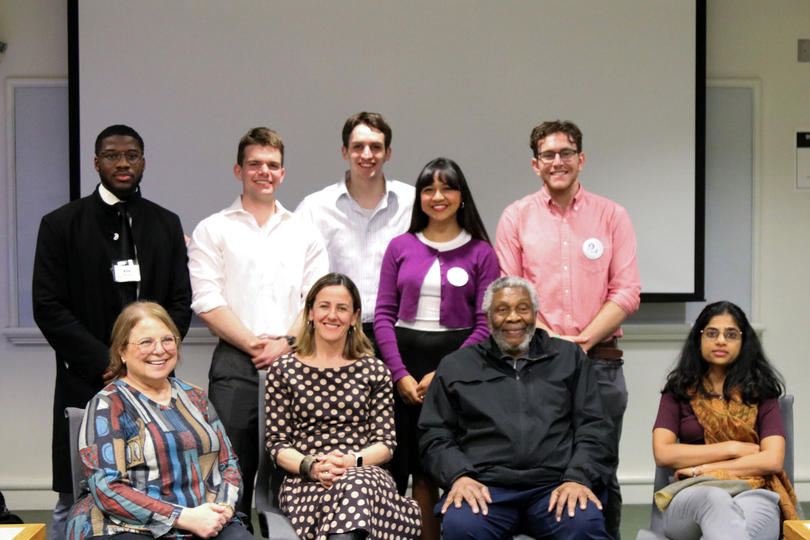SU Remembrance Scholars cohort, Women In National Security host panel to prevent violent extremism

The discussion was part of SU’s Remembrance Act Forward project, with the event's planning committee hoping to raise awareness about the growing threat of violent extremism. Avery Magee | Asst. Photo Editor
Get the latest Syracuse news delivered right to your inbox.
Subscribe to our newsletter here.
Syracuse University’s Remembrance Scholars cohort and Women in National Security organization hosted a panel of professors on Tuesday to explore ways the university and local community can prevent violent extremism.
The discussion comes amid a recent surge in violent extremism across the United States, fueled by white supremacy and anti-government ideologies. Since 2002, these beliefs have been responsible for more than 70% of extremist attacks and domestic terror plots, NBC News reported.
“We can’t ignore the reality around us, and it does take some courage, and it’s not easy to look at what’s happening,” Margaret Susan Thompson, an SU political science professor and the event’s moderator, said. “The first step is not to bury our heads in the sand.”
The discussion was part of the SU’s Remembrance Act Forward project. Josh Spodek, a Remembrance Scholar and member of the event’s planning committee, said the project assigns scholars into groups and charges them with educating the community on a topic they’re passionate about — in Spodek’s case, raising awareness about the growing threat of violent extremism.
The Remembrance Scholar program was founded after 1988 Pan Am Flight 103 was bombed over Lockerbie, Scotland, killing 270 people, including 35 SU students. As a Remembrance Scholar, Spodek hoped to educate fellow students about violent extremism and that the event would lead to further dialogue.
“We want to just educate and bring awareness to extremism on campus and beyond,” Spodek said. “The conversations that we had at this event really reflect what we were trying to do and get out of this whole project.”
Azra Hromadžić, a professor of anthropology, echoed Thompson’s message, using the Bosnian War as an example of the danger of ignoring violent extremism. In 1994, she watched nearby neighborhoods crumble under bombing, but couldn’t imagine any harm coming to her own home.
By the time the bombs started to fall, Hromadžić said it was too late for action.
“We cannot pretend it’s not happening,” Hromadžić said. “I was going to dance at a disco place, and the houses were burning 45 minutes away. I thought it would never happen here.”

Avery Magee | Asst. Photo Editor
Kumar said India’s caste system also serves as an important example of extremism.
Radha Kumar, a professor of history, discussed the prevalence of violent extremism in India, where Hinduism is the dominant religion, leaving practicing Muslims as a minority group that is often oppressed. Since 1950, roughly 10,000 Indian Muslims have died for practicing their faith, according to Brigham Young University’s Ballard Center for Social Impact.
Kumar said India’s caste system also serves as an important example of extremism, noting that the marginalization of lower castes has resulted in widespread suffering.
“In the context of South Asia, we have caste politics, where people of marginalized communities come together as a community to ask for their rights,” Kumar said. “People dismiss this as ‘identity politics,’ … but one thing that you learn from the South Asian context is nobody lacks identity.”
Horace Campbell, an SU professor of political science, said the marginalization of Jewish people in the lead up to World War II is a prime example of inaction that led to devastating violence. As antisemitism rose across Europe in the 1920s and 30s, many Americans didn’t consider the threat of powerful violent extremists severe despite reports from German journalists about Jewish persecution as early as 1933, he said.
Campbell drew parallels between the marginalization of minority student groups today and that of European Jews in the first half of the 20th century.
“The question for you and your generation is a question that was faced by German students in 1933,” Campbell told students. “German students in 1933 were faced with people who said other students in their classroom were not human beings, professors in their classroom were not human beings, and the students in Germany had to take a stand.”
In order to prevent future violence, Campbell said people must identify the signs and call out extremism instead of letting it persist.
Thompson echoed Campbell, and said simply discussing methods for combating violent extremism is a form of prevention. She said if people feel comfortable discussing extremism, they can develop a deeper understanding of it and feel safer taking action.
“Don’t feel that just because you’re not somebody who’s a marcher or a banner waiver or whatever, that you have nothing to do,” Thompson said. “There are all kinds of actions that you can do, and sometimes the most powerful action is talking to the person next to you and saying, ‘Are you having a hard time? Can I listen to you?’”
CORRECTION: A previous version of this article said Hromadžić’s home was destroyed by Russian bombs. The source of the bombing can not be definitively linked to Russia. The Daily Orange regrets this error.






